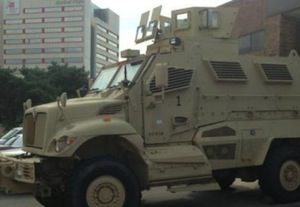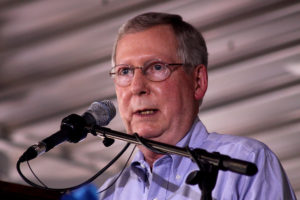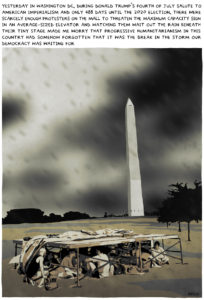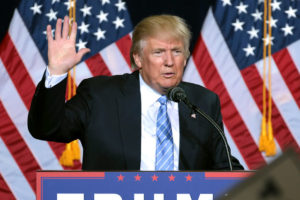The Complex Causes of a Student ‘Riot’
I believe the riot occurred because the basic components that create one are those we in the United States, wittingly or not, teach our youth: confrontation, belligerence, hyper-masculinity and the misuse of alcohol.
By Dick ConoboyThis October, alcohol and other influences led to what authorities called a student “riot” in the town of Bellingham, Wash. City officials and the local university administration denounced the participants’ behavior, praised law enforcement for forcibly dispersing the crowd, and promised to discipline those involved with expulsion and criminal charges. The following response to those actions was written by a Bellingham resident and published at Northwest Citizen. It appears here as an example of the kind of conversation Americans and their local leaders could have about the creeping militarization of their communities.
A recent report to the community following the 12 October “riot” entitled “Bellingham, WWU Working Together in Riot’s Aftermath,” written by Western Washington University President Bruce Shepard and Bellingham Mayor Kelli Linville, was an enormous disappointment. (You can read that piece on the city’s website here.) In the opening paragraph they asked: “How could something like this happen in Bellingham and what can we do to avert another similar incident?” They then proceeded in the next 1200 words to avoid the answer about “how could something like this happen,” except for these four sentences: “The causes of the riot were many. Drunkenness among college and high school students and non-students certainly was a contributing factor. Social media also played a part in the incident. The event fed upon itself via social media communications, pulling in more participants.” That’s it. In spite of stating that the causes were many, there is no enumeration of these “many” possible causes at all, except for booze and social media. The remainder of the editorial speaks to criminality, punishment, order, law, disappointment, civil disturbance training, party houses, etc., all of which are factors to be discussed but certainly neither all-encompassing rubrics nor edifying causes.
I believe this riot happened because the basic components that create these events are those we in the United States are teaching our youth. Confrontation. Belligerence. Hyper-masculinity. Misuse of alcohol. Wittingly or not, those are our messages. Stay with me while I explain.
Look at the photo above. This military vehicle is a recent acquisition by Ohio State University’s campus police force from the U.S. military. Read more about this acquisition here. The OSU campus police say it is for protection of their officers. A 19 ton armored personnel carrier. I had four similar vehicles under my command in the 1960s facing the Warsaw Pact, but I was an infantry platoon leader; a soldier in the 3rd Armored Division, not a police officer. Western Washington University has no such vehicle, yet. The city of Bellingham does have a similar one. So does the Whatcom County Sheriff. See the photos below. Bellingham police used their armored vehicle on the night of the “riot.” Like it or not, a message was sent to the crowd: this is a confrontation. Add to this the presence of police vehicles, flashing red and blue lights, spotlights, and bull horns. These visual and audio stimulants all added to the volatility of the situation. Is this a necessary response? Can we explore options?
At a meeting of the Mayor’s Neighborhood Advisory Commission several days after the “riot,” neighborhood representatives were able to discuss the incident of 12 October with Mayor Linville, Police Chief Cook and WWU’s VP for University Relations, Steve Swan. When my turn came to speak, I addressed the Police Chief. I reminded him that I spent over 6 years as a volunteer with the Bellingham Police Force. I wore their uniform. Ours is a police force I found to be well trained and one that worked well with the public. I told Chief Cook that I understood protection as I had been rescued by Bellingham officers on several occasions when threatened by irate members of the public whose vehicles I was about to tow and ticket. I also told him I had served in a combat zone and understood, more than most, the concept of protection, but that I had reservations about what our police departments were becoming. I said that when I see a photo of our police at that October incident and cannot distinguish that photo from one of an infantry squad in Kandahar, Afghanistan, there is a serious problem in our city. [See the photo of Bellingham police here.] Only one person at the mayor’s meeting contacted me after my remarks. She understood what I was saying. Otherwise, my remarks were met with polite and mildly stunned silence. Are such topics to be off limits?
What we are witnessing is a facet of a largely unacknowledged militarization of our police forces nationwide that began decades ago with the introduction of SWAT teams, the first of which appeared in Los Angeles. (You can read more about this by clicking here or merely by typing “police militarization” into your search engine.) Our young men and women see this transformation while also seeing first-hand the abuse, most recently with the treatment of Occupy Wall Street participants across the country, many of whom were on campuses. Even in Bellingham the former mayor forced a ham-handed response to clear the Occupy camp at Maritime Heritage Park. These were peaceful protesters. Annoying perhaps, but no cause was ever won by being docile and unobtrusive. Think of the civil rights protests of the 60s.
Let us consider the hyper-masculinity and belligerence that flourishes in the misnamed “sports” world. These characteristics unfortunately can be found at WWU and other universities that appear on the WWU sports schedule. I personally witnessed this phenomenon during my 7-8 years working crowd control at sporting events – primarily basketball and football (until the WWU football program was cancelled). Football is full of warrior talk: killing the opposition, crushing one’s opponents, smashing the other team. Team names and mascots across the U.S. promote notions of the same: Tigers, Lions, Cougars, Badgers, Huskies, Broncos, Eagles, Raiders, and WWU’s own Vikings (yes, we know what these ancient warriors did to the British Isles). There are even offensive team names such as the Redskins (Washington) or Rebels (Old Miss) that perpetuate insensitivity and cluelessness. In this atmosphere of rapaciousness and violence, even the uniforms imply a hyper-masculinity: shoulders exaggerated by padding, tight waists, celebratory head-butting, spiking the ball, undue displays of self-congratulation. Thus does poor sportsmanship proliferate. Females are not exempt from this distorted demonstration, for they provide support, often in the way of cheerleading where a hyper-feminization and sexualization plays a role in encouraging the crowds. A version of this was seen during the “riot” when young females “flashed” their chests or “twerked” against police cars.In the so-called “sports” world, coaches yell and scream at players. I spent years behind the bench of the visiting teams playing WWU football and basketball and witnessed this appalling behavior. Coaches were abusive. They screamed. Their spittle fell at their feet. Veins bulged on their necks and foreheads. Referees were not spared their ire. This is the comportment of so-called sports role models, the coaches. The players and fans alike pick up on this behavior. Fans become apoplectic. Botched plays are met with curses, throwing of helmets, knocking over of ice chests. No one is reprimanded for this behavior. The crowd picks up on the mood and this crowd mentality prevails. This atmosphere also permeates the growing number of “sports bars” where alcohol is fed into the mix. Inhibitions are relaxed and associations made: sports, alcohol, belligerence, confrontation, hyper-masculinity. Even women are now being pulled into this distorted dynamic.
There is also an inability of young minds to reason properly and modify risky behavior. We already know from scientific studies that the capacity for the young brain to make sound judgments (frontal lobe development) is not fully present until well after 20 years of age, even without adding alcohol. You will note this in a paper from the Juvenile Justice Center of the American Bar Association (click here – similar articles proliferate on the Internet). Yet in the aftermath of the “riot” here none of this is brought into the discussion.
Similarly, we have not looked at the role of alcohol in this and similar incidents in a wider, cultural context. Malcom Gladwell presented some fresh insight into the behavior of those who drink in an article entitled “Drinking Games.” You can read that piece in its entirety at his website by clicking here. Gladwell posits: “Myopia theory changes how we understand drunkenness. Disinhibition suggests that the drinker is increasingly insensitive to his environment—that he is in the grip of an autonomous physiological process. Myopia theory, on the contrary, says that the drinker is, in some respects, increasingly sensitive to his environment: he is at the mercy of whatever is in front of him.” Consider what was in front of this group of “rioters” on the 12th of October in relation to what Gladwell is saying.
Gladwell continues, “In other words, the frat boys drinking in a bar on a Friday night don’t have to be loud and rowdy. They are responding to the signals sent by their immediate environment—by the pulsing music, by the crush of people, by the dimmed light, by the countless movies and television shows and general cultural expectations that say that young men in a bar with pulsing music on a Friday night have permission to be loud and rowdy. Persons learn about drunkenness what their societies import to them, and comporting themselves in consonance with these understandings, they become living confirmations of their society’s teachings,” MacAndrew and Edgerton [anthropologists Craig MacAndrew and Robert B. Edgerton] conclude, “Since societies, like individuals, get the sorts of drunken comportment that they allow, they deserve what they get.” The hidden expectation that night could very well have been that being drunk would bring on riotous and destructive behavior. The young crowd was behaving as a young drunk crowd is defined in our culture. So as I said above in the first few paragraphs, a message was being sent to the crowd from the current culture.
Gladwell concludes, “There is something about the cultural dimension of social problems that eludes us. When confronted with the rowdy youth in the bar, we are happy to raise his drinking age, to tax his beer, to punish him if he drives under the influence, and to push him into treatment if his habit becomes an addiction. But we are reluctant to provide him with a positive and constructive example of how to drink. The consequences of that failure are considerable, because, in the end, culture is a more powerful tool in dealing with drinking than medicine, economics, or the law.” Might we then also conclude that we have until now only addressed the economics (damage to vehicles, property, etc.) and the law (find the perpetrators and punish them)?
In order for citizens to have a well-balanced conversation on the incident of 12 October, we must consider the totality of the elements that feed into these kinds of behaviors on the side of the “rioters” and the city officials, notably our police. Do not misunderstand. This is not an indictment of city hall, the police, the university or those who “rioted,” be they students or other young residents. It is a call to action. It is a call to talk about uncomfortable topics by expanding the conversation.
I call on Mayor Linville, Police Chief Cook and WWU President Shepard to expand the discussion. We can learn much from this incident. To do less will be to miss an opportunity to get to the heart of the matter.


Independent journalism is under threat and overshadowed by heavily funded mainstream media.
You can help level the playing field. Become a member.
Your tax-deductible contribution keeps us digging beneath the headlines to give you thought-provoking, investigative reporting and analysis that unearths what's really happening- without compromise.
Give today to support our courageous, independent journalists.






You need to be a supporter to comment.
There are currently no responses to this article.
Be the first to respond.